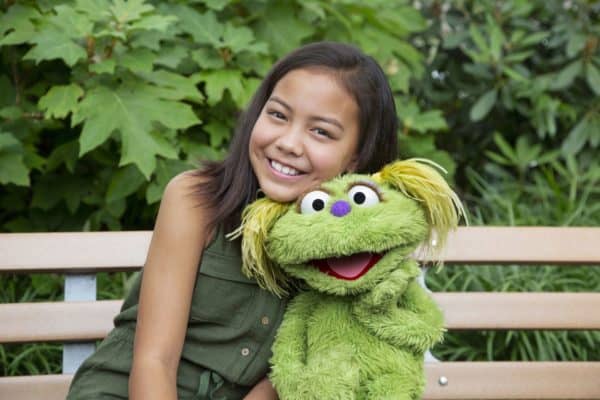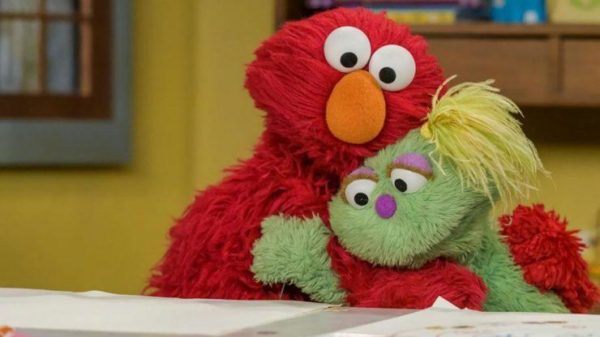Ben Lehmann, now its executive producer, was just 2 years old when the very first episode of “Sesame Street” was shown, way back in 1969 – a year when U.S. parents and their children were regularly witnessing death and atrocity over in Vietnam on their TV screens. It had also only been a year since the tragic assassination of Dr. Martin Luther King. However, here was a radical new children’s television program that spoke a similar message to that of Dr. King, directly aimed at those very same kids.
“There’s a lot of kids who are in foster care, and there’s not a lot of content out there speaking to them. Diversity and inclusion have been part of our mission from the very beginning.” – Ben Lehmann, Sesame Street’s current executive producer, on the introduction of Karli, a muppet character now in foster care because her mother suffers from opioid addiction.

Sesame Street: Its Original Concept & Continuing History
It all began way back in 1966 with a small dinner party in a Manhattan apartment, overlooking the delightful Gramercy Park, one of only two privately-owned parks in New York City. Hosted by Joan Ganz Cooney, a television producer with a keen interest in children’s educational TV, also at the table were her husband, Tim Cooney, her boss Lewis Freedman, and Lloyd Morrisett, a Carnegie Corporation executive. Unsurprisingly, the discussion turned to the subject of television’s potential to be a platform for teaching small children. It was decided that Ganz Cooney would oversee and direct the creation of what would later become Sesame Street as we know it today. She was also named the first executive director of the Children’s Television Workshop (CTW), the organization that oversaw Sesame Street’s production. As one of the very first female executives in American TV, her high-profile appointment was regarded as “one of the most important television developments of the decade.” Lloyd Morrisett, an experimental psychologist with a career in education, communications, and philanthropy, also came on board as one of the show’s creators and a co-founder of CTW (later to become the Sesame Workshop). Together, Ganz Cooney and Morrisett worked with chief advisor Harvard University developmental psychologist Gerald Lesser. in the development and content of Sesame Street. In 1974, Lesser wrote “Children and Television: Lessons From Sesame Street,” which detailed how Sesame Street was developed and finally got on the air. Of course, someone had to create the engaging characters who would live on Sesame Street, and who better than the legendary “muppeteer” Jim Henson, creator of global mega-movie star Kermit the Frog? As Steve Youngwood, the chief operating officer of Sesame Workshop, remarked: “If they could harness that power to teach them the alphabet and their numbers as opposed to the words to beer commercials, you may be able to make a really big difference.” Sesame Street, set on an urban street with a multicultural cast, had one simple goal – to help minority and low-income little learners (aged 2-5) receive the complete basic education that schools back then were failing to adequately provide them. With humans living side by side with animals and even monsters, the message was as clear then as it is today – diversity and inclusion.

Confronting the Real World on an Imaginary Street
Sesame Street has never shied away from introducing and discussing serious themes to its young audience. When Will Lee, the actor who played Mr. Hooper, the friendly neighborhood grocer and one of the original 4 human inhabitants of Sesame Street, died in real life of a heart attack, his sad demise provided the program’s creators with an alternative teaching opportunity – how to explain death to children. “Farewell, Mr. Hooper,” which aired on November 24, 1983, is best remembered for Big Bird’s reaction to his friend’s passing as he learns the kind grocer will no longer be able to make him the birdseed milkshakes he so adores. The death of the character was clearly revolutionary at the time because it discussed the subject in a frank way that was accessible to children, and, importantly, the permanence of death was understandable to its young audience. In just one episode, Sesame Street was able to truly define its ongoing mission: to teach children about the diverse, challenging world they live in, as well as their numbers and letters. However, death has not been the only difficult subject Sesame Street has dealt with over the last 50 years:
- Racism: When their friendship is criticized via a telephone call, Gina (who’s white) and Savion (who’s black) talk about the situation to Telly Monster – “Telly, there are just some really stupid people in the world who can’t stand to see when people of different races are friends,” Savion says.“Because Sav’s skin is brown and mine is white he thinks we shouldn’t be friends,” Gina adds. So when Telly asks what color has to do with being friends, Gina replies, “Nothing, nothing at all.”
- HIV: In the South African version of “Sesame Street” called “Takalani Sesame,” the show introduced Kami – an HIV-positive muppet, who teaches basic facts about HIV and tackles the disease’s stigma.
- Down Syndrome: Jason, a young boy with Down syndrome, made his Sesame Street debut when he was just 15 months old. His mom, Emily Kingsley, a writer for the show, used her experiences with her son to push for more inclusion for disabled children. Jason appeared in 55 episodes during the 1970s.
- Incarceration: In one of the show’s resource videos, muppet character Alex explains to his friends that his dad is “in jail” when they¡re talking about their dads. His friend, Sofia, then says that her dad was in jail when she was younger, and she explains what “incarceration” means while offering support to Alex.
“We now know what we didn’t know 50 years ago, which is that kids actually love longer narratives.” – Ben Lehmann, Sesame Street’s current executive producer
- Adoption: In the 1980s, the show taught kids about adoption when its characters Susan and Gordon Robinson told their neighbors they were going to adopt a son named Miles. In 2006, Gina shared her announcement that she was adopting a boy from Guatemala.
- Autism: In April 2017, Sesame Street introduced its first new muppet in 10 years – Julia, an autistic 4-year-old girl, sunshine-yellow, a great little artist, and never without her beloved rabbit, Fluffsterits. In the episode’s opening scene, Big Bird walks says hello to Julia but is upset when she doesn’t look up from her painting. An adult tells him, “She has autism, and she likes it when people know that. For Julia, it means that she might not answer you straight away. And she may not do what you expect, like give you a high five.” Another muppet adds, “She does things just a little differently, in a Julia sort of way.”
And now, with the introduction of Karli, the real-life, challenging topics of foster care and addiction are discussed.
The U.S. Foster Care System
Foster care is the temporary custody or guardianship for children whose parents have either passed away or, at present, are unable to look after them adequately enough to satisfy the state. They are then cared for by trained caregivers, approved by the state, including kinship or relative caregivers until such time as their parents’ situation changes for the better. However, sadly, sometimes that never happens. The State in question, eg. Washington state, through the family court and child protective services agency, are “loco parentis” – Latin for “in place of a parent” – meaning they make all legal decisions regarding the child on behalf of the child’s parents, and the “foster parent” is responsible for the day-to-day care of the child.
U.S. Foster Care Statistics
For the first time since 2012, there are now fewer children in the U.S. foster care system, according to estimated data released by the U.S. Department of Health and Human Services in August of this year. However, thousands of children continue to be placed into the system for a whole spectrum of reasons, including substance addiction. That surge from 2012 onwards was seen as a direct result of the prescription opioid epidemic that still continues to this day. The AFCARS (Adoption & Foster Care Analysis & Reporting System) report recorded 437,283 children in foster care as of September 2018 – the previous year, it had been around 441,000. In 2002, the system’s peak child population was 524,000. The biggest decreases in the foster care population were recorded in Arizona and Indiana, which were among the states where the numbers had soared earlier in this decade. However, the current number of children in foster care waiting to be adopted also increased, rising from 123,754 to 125,400. The average amount of time that a child spends in foster care is a little over a year, with the most common cause being parental neglect. Many of these cases of neglect are as a direct result of substance abuse and addiction.
Children with “Special Needs” in U.S. Foster Care
There is a phrase used in the sphere of foster care that has led to several misconceptions because it normally relates to a disability. However, having “special needs” covers a host of factors that relate to whether a child will receive continuing state help after they are adopted, known as “Adoption Assistance.” These “special needs” factors (or conditions) can include:
- Being an older child
- Racial or ethnic background
- Being part of a group of siblings group, ie. requiring joint placement.
- Medical conditions
- Physical, mental, or emotional disabilities
Foster Care in Washington State
In Washington state, the issue of parental neglect is a prominent one, as is the lack of foster homes willing to take children in need of foster care or adoption. For example, in King County, and other counties to the north, over 1,000 foster children actually stayed in hotels between September 2017, and August 2018, because there are not the number of available homes needed for them. Many children and adolescents (aged 5 -17) who have stayed in hotels, and even on occasion, spent the night in state offices, also have the special needs described earlier, such as mental health needs or a history of self-harm. One extreme example is that of a 16-year-old girl who spent 67 consecutive days in a hotel before moving on to an out-of-state group care facility. In another extreme case, two siblings (an infant and a toddler) spent one night in a hotel when both their parents were being held in prison. Unsurprisingly, such a situation resulted in Washington’s Child Welfare Secretary calling it simply “disastrous for children.” Because of the opioid epidemic, Washington state has seen a sharp rise in the number of children in foster care since 2012 – a rise of 20% to more than 9,000. 
The Destructive Trail Left By The Opioid Epidemic
Today, opioid-based prescription painkillers now seem to be as common in our nation’s bathroom cabinets as the humble aspirin. Just that fact in itself is one of the main reasons we are in the midst of an opioid crisis, with many U.S. citizens in dire need of drug rehabilitation services. More than 100 people continue to die every single day from an opioid-related overdose. The destructive trail left by this epidemic has affected every single U.S. demographic, and, even though those opioid-related overdose rates now appear to be declining, for some, that trail will still prove fatal, including the parents of kids in foster care. The Centers for Disease Control and Prevention currently estimates that the “economic burden” endured nationwide of just the misuse of prescription opioids, just like Karli’s mother, stands at around $78.5 billion a year in total. Here are just a few of the available, and deeply frightening, statistics about the extent of the crisis:
- 21 – 29% of patients prescribed opioids for chronic pain will misuse them.
- 8 – 12% will go on to develop an opioid use disorder.
- 4 – 6% who misuse such opioids will transition to heroin.
- Predominantly still, it is the young at the most vulnerable from opioid addiction; however, every U.S. demographic is suffering.
- The Midwestern region of the U.S. witnessed opioid overdose increases of a massive 70% from July 2016 to September 2017.
- In 2017, Idaho medical providers wrote 70.3 opioid prescriptions for every 100 persons Although this figure represents Idaho’s lowest prescribing rate in over 10 years, it is still higher than the national average of 58.7 opioid prescriptions.
In 2017, 742 overdose deaths involving opioids were formally recorded in Washington state, with the greatest increase in opioid deaths occurring among cases involving heroin. Synthetic opioid (mainly fentanyl) involved deaths also increased from 59 deaths in 2013 to 143 deaths in 2017, though deaths from prescription opioids thankfully decreased during those years.
How Karli’s Story Repeatedly Plays Out in Washington State
The story of Karli, Sesame Street’s new muppet character, in foster care, because her mother has a prescription opioid addiction, is sadly a familiar one on the real-life streets of Washington state. In October of 2018, Washington Attorney General Robert Ferguson reported that nearly half of the state’s child dependency cases (where children have been abused, neglected or abandoned) involved opioid abuse. “When one is facing a crisis, we need to act like it,” Ferguson said. “Right now, Washington state is simply not doing that.” Around 100 attorneys in the Attorney General’s Office regularly work on cases involving dependent children and the termination of parental rights. In a July 2018 survey, 76 of those same attorneys said that opioid abuse was a factor in 47.9% of dependency cases and 39.9% of parental-rights cases. The data collected from this survey obviously doesn’t include specific details or where in Washington they occurred. However, some of the attorneys surveyed did offer up some case histories with only general details. Here are a selection of these:
- Case #1: A former nurse, who was fired for opioid drug thefts and then became homeless, lost her 6 children, who now live in different locations, split between foster care and out-of-state treatment programs.
- Case #2: 3 children were removed from their heroin-addicted parents when their third child tested positive for opiates at birth. The father later overdosed and died – the mother “disappeared into her addiction,” and sadly, she has not seen her children since.
- Case #3: A 28-year-old mother, who had abused alcohol and opioids since age 13, began to experience delusions where “ghosts and demons possessed her and her child.” She subsequently lost her children.
As Attorney General Bob Ferguson said at the time, these new survey numbers “add another perspective to this issue, which is a voice that really can’t be heard: kids. They’re not in a position to advocate for themselves, but are most certainly being harmed in ways that are hard to imagine.” 
How Northpoint Washington Can Help You
As part of the Northpoint group of addiction treatment facilities, Northpoint Washington takes an integrated approach to treating patients, who stay at our modern, 22-bed inpatient center, located in Edmonds, just north of Seattle. There, they are treated for both the physical dependence, including that of opioids, that causes painful withdrawal symptoms, and the underlying psychological conditions at the root of their addiction, before moving on to our personalized outpatient program. Northpoint Washington offers this detox/rehab/aftercare-orientated treatment strategy to first get you sober safely, and then to keep you sober as you learn the coping mechanisms for your drug-free life ahead. It is only right that the last few words in this article should go to the woman who held that dinner party in Manhattan all those years ago – Joan Ganz Cooney, one of the original creators of Sesame Street. In the 2006 documentary, “The World According to Sesame Street,” Ganz Cooney compared the work of the program to olden-day missionaries, but instead of religion, the Sesame Street team is “spreading tolerance and love and mutual respect.” And may they long continue to do so.
